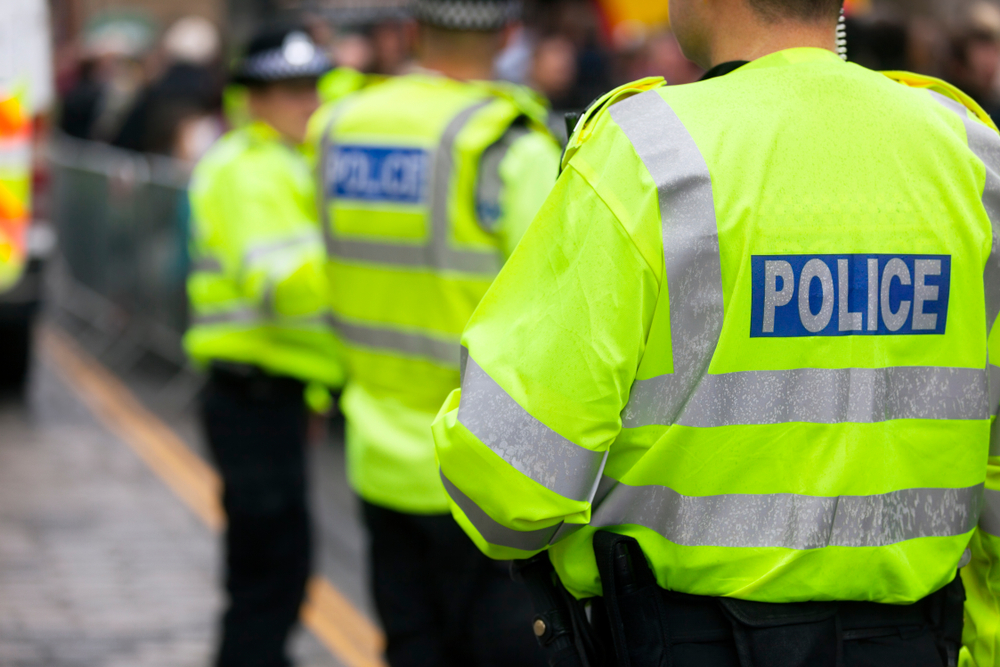Home > Services > Conflict Resolution Training > De-Escalation Training > Police Officers
On-Demand Training Course
- Approximately 90 minutes to complete
- Includes interactive practice exercises and multi-media lessons
- Includes Certificate of Completion
Need to enroll 10 or more participants? Request Bulk Order
The Need for De-Escalation in Law Enforcement Agencies
The pressing demand for de-escalation training for police officers has surged due to significant events that emphasize the sometimes controversial use of force. For a long time, certain communities have been viewing law enforcement officers through a lens of skepticism, often questioning their actions as aggressive or out-of-line.
Incorporating consistent de-escalation training can help modify these perceptions and further officers with tools essential for their safety and the well-being of citizens.
Making de-escalation a cornerstone of policing can substantially reduce the necessity for use of force incidents. For police departments across the United States to maintain the trust and confidence of the citizens they protect, putting an intensified focus on de-escalation techniques and their application becomes absolutely vital.
Understanding the specifics of every situation is crucial. Police officers should swiftly conduct comprehensive threat assessments informed by details from dispatchers and other officers. This aids in making calculated decisions and avoids force incidents whenever possible.
Ascertaining the nature of the call, recognizing any mental health issues or the potential presence of weapons, and gauging the overall temperament of the situation are key aspects of this assessment.
The role of communication in achieving voluntary compliance cannot be understated. Clear, concise, and non-confrontational directives foster cooperation. Using respect as a foundation, de-escalation techniques ensure that confrontations are minimized, leading to safer outcomes for both the officers and the subjects involved.
Benefits of De-Escalation Training
De-escalation training equips law enforcement with essential skills vital for contemporary policing. Among these advantages are:
- Enhanced communication: Officers learn to communicate effectively, fostering communication that’s both clear and conducive to voluntary compliance. This significantly reduces misunderstandings that can escalate situations.
- Reduced use of force: By mastering de-escalation techniques, officers can minimize the frequency and intensity of use of force incidents. This results in fewer injuries and legal complications.
- Improved officer safety: The training emphasizes assessing situations, ensuring officer safety without compromising the safety of citizens. Knowledge of de-escalation tactics can often prevent potentially volatile situations from getting out of control.
- Strengthened community trust: Trust is foundational in law enforcement. By consistently applying de-escalation techniques, police can foster a stronger bond with community members, resulting in collaborative public safety efforts.
- Emotional intelligence and empathy: Training hones emotional management and empathy. Officers equipped with these skills are better at reading situations, understanding the emotions of involved parties, and using de-escalation techniques tailored to the situation.
- Professional development: De-escalation training contributes to the officer’s overall development. It refines decision-making skills, instills confidence during demanding circumstances, and emphasizes the sanctity of human life.
- Cost efficiency for departments: Fewer use-of-force incidents means fewer legal entanglements, medical bills, and reduced liabilities for police departments.

Key De-Escalation Techniques and Principles
In the intricate and frequently demanding landscape of law enforcement, the focus on de-escalation techniques has increasingly become crucial. As communities and police departments grapple with tense situations, the need for effective communication and conflict resolution strategies is evident.
Active listening stands as a cornerstone of these techniques. More than just processing spoken words, it involves delving into the emotions and concerns underlying them. By practicing active listening, police officers can establish a connection and build rapport and trust, which are essential for peaceful conflict resolution.
Body language plays a key role in these interactions. The intricacies of non-verbal communication, from facial expressions to posture, can offer officers a deeper understanding of a subject’s mindset. Recognizing these cues and responding appropriately can often be the difference between escalation and resolution.
Tactical de-escalation provides officers with practical strategies to manage potentially volatile situations. Techniques such as creating space or using time to an officer’s advantage can defuse tension, allowing officers the opportunity to assess and approach situations with a clear mind.
The critical decision-making model is another invaluable tool that offers a structured methodology for officers to evaluate tense situations. This model guides them in assessing the context, considering various outcomes, and ultimately making decisions that prioritize the safety of all involved.
Understanding the distinction between escalation techniques and de-escalation techniques is crucial. While escalation techniques might inadvertently intensify a situation, de-escalation aims to bring calm and understanding.
By integrating these de-escalation techniques into their training and daily operations, law enforcement agencies can promote more positive interactions with the community, reducing the risk of use-of-force incidents and fostering a more collaborative relationship with the public they serve.
Training Programs and Their Impact
In the evolving landscape of law enforcement, one effective approach to de-escalation training is the train-the-trainer program. As the name suggests, this approach equips a select group of officers with advanced skills, enabling them to subsequently train their peers. This cascading method ensures that de-escalation techniques are consistently and effectively disseminated throughout a police department.
The rise of online training has further democratized access to these crucial resources. It provides a flexible platform for law enforcement officers from various agencies to tap into best practices from anywhere, anytime. This adaptability is especially beneficial in catering to the diverse schedules and demands of modern policing.
Institutions like the Force Science Institute have been instrumental in the research and development of these training modules. Additionally, the Peace Officer standards play pivotal roles in shaping the content and quality of these training courses, ensuring they are both relevant and rigorous.
However, the sheer number of training hours dedicated to de-escalation in police training is a testament to its importance. It underscores the commitment of modern law enforcement to prioritize peaceful resolutions, aiming to safeguard both the community and the officer in every encounter and fostering trust between the police and the communities they serve.

Pollack Peacebuilding’s Comprehensive De-Escalation Training
As situations escalate in various environments, from bustling corporate offices to the streets of our cities, the emphasis on de-escalation training is more pressing than ever. This training becomes paramount, especially for those who regularly encounter emotionally triggered individuals or for anyone keen to be primed for unpredictable, intense scenarios. With Pollack Peacebuilding at the forefront of conflict management, why should you consider us as your go-to for this essential training?
What to Expect from Our De-Escalation Training
Our training module equips you with a repertoire of conflict resolution and de-escalation tactics. These include:
- Recognizing early warning signs: Before aggressive behavior takes root, be equipped to pinpoint and mitigate triggers.
- Managing personal emotions: Learn the art of self-control, ensuring you remain composed and safe in confrontational situations.
- Techniques to reduce emotional intensity: Familiarize yourself with strategies to decelerate heightened emotional responses both in oneself and others.
- Effective communication tools: Adopt the right body language, tone, and phrasing to seamlessly de-escalate tense situations.
- Prioritizing safety: Navigate intense confrontations with a safety-first approach for everyone involved.
Pollack Peacebuilding’s de-escalation training is versatile, catering not just to corporate leaders but extending its relevance to roles that require public interaction. It simplifies complex tactics, making them memorable and practical for real-life applications.

Who Benefits the Most from Our Training?
While de-escalation training is universally valuable, specific roles gain exceptionally from it. Roles such as customer service agents, security personnel, police officers, event managers, and other client-facing professionals can utilize this training to effectively handle unpredictable situations. With both in-person and online training available, Pollack Peacebuilding Systems ensures accessibility and flexibility.
The Impact of Training on Professional and Personal Life
In professional settings, mastering de-escalation techniques promotes a harmonious work environment. Effective supervisors can swiftly identify and pacify verbal conflicts, ensuring cohesive teamwork. Given the intense nature of certain jobs, this training becomes an invaluable asset, equipping employees to manage high-stress scenarios confidently.
De-escalation training further enhances interpersonal relationships. It fosters improved communication, active listening, and empathetic understanding—qualities that elevate one’s role as a friend, family member, or caregiver.
Why Pollack Peacebuilding Systems Stands Out
Pollack Peacebuilding’s expertise is not merely academic but grounded in real-world applications. For professions already exposed to de-escalation training, like law enforcement, external training provides a fresh, expert perspective. Pollack Peacebuilding offers this expertise, ensuring effective communication in crisis situations and enhancing safety during potentially hazardous incidents.
Challenges and the Way Forward
In law enforcement, the complex concept of constantly engaging in de-escalation has its challenges and opportunities. While de-escalation training equips them with the tools to handle tense situations, the real-world application can be intricate. Every officer’s last encounter with community members shapes the citizens’ base perception of the police, underscoring the importance of positive interactions.
As we move forward, the focus should be on continuous learning, adapting to new challenges, and ensuring that every single citizen encounter reinforces trust and collaboration. The path ahead may be challenging, but with commitment and understanding, a harmonious future is achievable.

